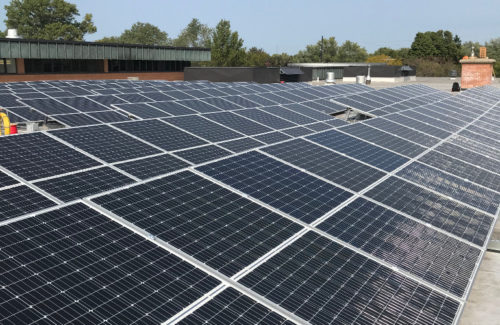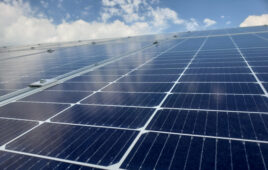Ignoring their price (especially during this period of is-it or is-it-not exempt from import tariffs), using bifacial solar panels on flat roofs makes sense in nearly every application. Bifacial modules, which produce power from both sides of the glass, generate the same amount of energy from their frontside as monofacial panels. If bifacial modules eke out even the smallest amount of generation from their backside, that’s just bonus without even trying. Add in a highly reflective roof surface and the right tilt angle and your commercial rooftop project is guaranteed a higher ROI.

A bifacial installation by Emergent Solar Energy at Valparaiso University in Indiana utilizing TerraGen Solar’s TGR mounting system.
Emergent Solar Energy, a commercial and agriculture solar installer in Indiana, has done just a few bifacial installations on flat roofs, but managing partner Jeremy Lipinski is itching to do more.
“We did a small 40-kW bifacial project for a mixed-use building, mounted in portrait at 15°. At 15°, I’ve seen a good 4 or 5% increase over our non-bifacial products,” he said. “I don’t know what’s going to happen with tariffs, but if I can get 5% more and it doesn’t cost any more to the buyer, that is absolute gain. If it’s a white membrane roof, then why not?”
Both module manufacturers and mounting system producers have seen an uptick in orders for bifacial projects on flat roofs in the last two years, likely attributed to the specialty panels’ exemption from the import tariff.
Alex Vanasse, VP of business development for mounting manufacturer Opsun, said bifacial modules were averaging 40-cents/watt, bringing them within the same price range as premium monofacial products. But now with an official ruling that bifacial imports will be taxed at the same rate as its one-sided cousins in 2021, commercial-focused solar suppliers are trying to keep that momentum going.
U.S. contractors looking to skirt import taxes entirely have to look no further for bifacial modules than Prism Solar, an American panel manufacturer with a New York factory and relationships with two U.S. OEMs for a domestic manufacturing capacity of 200 MW — all bifacial. Prism Solar started as a concentrating collector company that used holographic elements with bifacial PV cells. Eventually focus shifted to just PV modules, and Prism has been involved with bifacial for almost 15 years now.
“We were doing research with Sandia 10 years ago with bifacial,” said Paul Hauser, CEO of Prism Solar. “We could pivot all the engineers working in the holographic optical space into developing rate tracing and other methodology for bifacial. As a module company, typically you don’t have that level of engineering driving the product.”
Prism concentrates solely on the U.S. C&I space along with architectural and custom builds — so it knows all about the benefits of bifacial on flat roofs. Prism works directly with commercial clients with multiple locations ideal for solar, like JPMorgan Chase Bank and its many branches. The company has found success by securing a Private Letter Ruling (PLR) that proves its bifacial solar solution harnesses light reflected off the roof, making the roof an integral and inseparable part of the solar array. This therefore qualifies a new roof installation to take advantage of the solar ITC.
Since Prism can loop a new roof in with a solar project for the ITC, the company does a lot of commercial installations on white roofs. Through its own methodology determining height, tilt and the amount of reflected light (albedo), Prism also works with racking partners to ensure there’s minimal shading on the back of the panel for the highest bifacial gains. Opsun is a popular development partner.
The flat-rooftop solar business has largely been transitioning to modular racking — using resin trays that are easy to position. Bifacial systems do require reverting back to the basics with rail-based mounting systems, in which Opsun specializes.

Emergent Solar Energy used TerraGen Solar‘s TGR mounting system on this Green Alternatives project in Indiana.
“It would be difficult with a modular rack to expose the back and have a solid enough structure to hold it all in place,” Vanasse said. “With rail-based, you create a square structure, and it allows you to raise the tilt. You want to expose the backside as much as possible at 10 to 15° at least.”
Bifacial modules must be situated higher on the roof with more space between rows to prevent under-array shading. Where monofacial panels may be clamped 4 in. above the roofline, bifacial should be at least 15 in. above, Vanasse said.
“As you raise the panel from the roof, it makes a gap that light can go into. More light can bounce and more diffused light can reach the back,” he said. “You get a lot of gains from the backside that way.”
These extra design considerations toward backside gains may lend to fewer panels being used on more expensive rail-based racks, but those bonus gains make up for it.
“You pay more to get a system that ends up getting you a better return on investment,” Vanasse said. “If you have a white roof, going bifacial will only increase your ROI.”
Module-level electronics, like power optimizers and rapid shutdown devices, are installed on the rack’s rails just like with a normal installation. Most bifacial modules are moving into half-cell designs, which lets them function as two separate halves, making shading impacts less severe.
Emergent Solar Energy’s Lipinski said his company’s bifacial projects are some of the cleanest designed.

Emergent Solar Energy used TerraGen Solar‘s TGR mounting system on this Green Alternatives project in Indiana.
“Your wire management matters. We do everything we can to get those channels clear. We don’t have wires hanging,” he said. “You don’t want anything obstructing any kind of light.”
Some additional design considerations for bifacial on flat roofs include understanding how the panels work in certain latitudes. In all cases, a bifacial module will outperform a monofacial module just because of the chance of backside gains.
“Everyone thinks that if you have a bifacial module, you need to reflect the light into the back of it,” Hauser said. “The reality is, depending on your latitude, there is a difference in sky-scattered albedo. In Tucson, you’re going to have a bunch of light on the front and a decent amount reflected. The same installation [in Arizona] looks like you’re producing less than in Minnesota. Their light is more diffused, so you’re producing more from the back. The further away from the equator, the more you get from the backside.”
Do bifacial modules work better in the Northeast than in the Southwest? The backside performs better in the Northeast, but the front performs better in the Southwest — so, it’s complicated. But there is no right or wrong spot in the country for bifacial modules on roofs. They just need enough space behind the module to get some reflected gains — and that greater return on investment.
For clarification, the images supplied by Emergent Solar Energy use TerraGen Solar’s standard TGR flat roof mounting system with a 17.5° tilt. While TerraGen does offer bifacially optimized mounting systems, the company said it has seen a rise in popularity of its standard TGR system in portrait with a higher degree tilt angle being used with bifacial modules.






The Theoretical max of “30% increase” is on the efficiency not on the output. 22% * 1.3 = 28.6% not (400* 1.3 =520W) and that is when there is a near-perfect backplate with no solar shading from other panels.
I manufacture a roof coating called Davlin Sunshield 3800, which was designed to be highly reflective and stay clean. CRRC rates our Sunshield with a SRI of 111 and 3 year aged SRI of 105. Solyndra engineers selected our coating as superior to all other roof coatings under their solar arrays. They claimed it improved their panel performance by up to 30%. Unfortunately, Solyndra went BK before the rollout.
I am interested in working with someone to test our Sunshield 3800 with bifacial panels to measure the results. You can contact me through my website. http://www.davlincoatings.com
My project at 918 Ulster Avenue, Kingston, NY used OpSun racking mechanically attached at 30 deg tilt and the lower edge of the Prism bifacial panels were fully 24” above a white TPO roof. Frontside DC rating is 154 kW driving 166.5 kW of inverters, yes we are less than 1:1 DC to AC and clip the inverters ALL THE TIME when there is sun. The power output distribution over the hours of the day is broader and more even than a frontside-only installation. Summer sun rises in NE and sets in SW here. Row spacing becomes very important as do some other tricks, but Paul Hauser knows of what he speaks: NE installs (I’m 41N lat) can take advantage of a lot of albedo diffuse light.
Not mentioned in the article is the opportunity to leverage bifacial technology to advantage in solar+storage installations. Some pics at http://www.insidetracksolar.com
I remember a system manufacturer that made panel and racking system efficiency claims based on secondary backside panels with reflective coatings. Those claims were later shown to be ‘overblown’ market hype.
So, in the spirit of “Fool me once shame on you, fool me twice shame on me”; is there any non-anecdotal and impartial testing by NREL to reference and validate the efficiency and cost assertions made in this article. More details, and links to source research, on the existing methods used to analyze produced energy, and the significant contributing factors (like measured albedo effect) for gains would be most appreciated. As we all know, the devil is in the details. If we don’t have data to calculate these values into production modeling and design tools, it’s not very helpful. Thank you.
For clarification, images 1, 3, and 4 in this editorial show TerraGen Solar’s standard TGR flat roof mounting system with a 17.5 degree tilt. While TerraGen does offer bifacially optimized mounting systems, we have seen a rise in popularity of our standard TGR system in portrait with a higher degree tilt angle being used with bifacial modules.
I’m guessing his roofs are silver approximate ie zinc / galvanised? 5% sounds more like it and possibly at the top of the scale. Some crazy numbers were bantered around in early days ie 30% increase in output. Not sure if that is just at a certain time of day representing certain solar geometry in addition to a silver roof (most likely to be zincalume or galv). Can this technology be extended to Sunpower Maxeon 400W? I Would think not as they have the copper plate behind which would surely block the light. How would those panels perform if they were reengineered around the bifacial approach. Lots of questions to be answered but I think that multi layer may get up and supplant bifacial approaches eventually as we’re already maxing out what we can get out of single layer monos.
“”In Tucson, you’re going to have a bunch of light on the front and a decent amount reflected. The same installation [in Arizona] looks like you’re producing less than in Minnesota. Their light is more diffused, so you’re producing more from the back. The further away from the equator, the more you get from the backside.””
I can also see in Minnesota if it snows the reflected albedo would also help with back side generation while helping melt the snow on the panel’s top side. Sure, after a snow storm in the north east, one might have a very crisp sunny day after a storm front moves through. During those times one might pick up instead of two hours of solar insolence after it snows, you might have back side generation that helps the snow slough off of the panels and begin to pick up more solar insolence and extend that day to 3,4 hours equivalent solar harvest, even in wintertime.